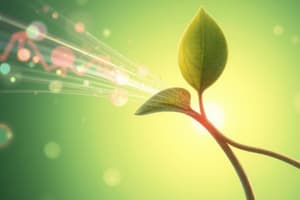Podcast
Questions and Answers
Which of the following is NOT a consequence of photorespiration?
Which of the following is NOT a consequence of photorespiration?
- Increased ATP production (correct)
- Production of 2-C compounds instead of 3-C compounds
- Reverses carbon fixation
- Short circuit of the Calvin cycle
What is the primary reason for the occurrence of photorespiration?
What is the primary reason for the occurrence of photorespiration?
- High levels of carbon dioxide
- Low levels of oxygen
- Low levels of carbon dioxide (correct)
- High temperatures
How does the salvage pathway in photorespiration help mitigate its negative effects?
How does the salvage pathway in photorespiration help mitigate its negative effects?
- By directly converting 2-C compounds back to 3-C compounds
- By recycling RuBP through three organelles (correct)
- By increasing the efficiency of the Calvin cycle
- By directly producing sugars from 2-C compounds
What is the main advantage of plant adaptation, in relation to photorespiration?
What is the main advantage of plant adaptation, in relation to photorespiration?
Flashcards
Photorespiration
Photorespiration
A process that consumes oxygen and releases carbon dioxide, reversing carbon fixation in plants.
Calvin cycle short circuit
Calvin cycle short circuit
Photorespiration disrupts the Calvin cycle by converting 3-C molecules to 2-C compounds.
Wastage in photorespiration
Wastage in photorespiration
Energy is wasted in regenerating RuBP with no sugar produced.
Recycling of 2PG
Recycling of 2PG
Signup and view all the flashcards
Plant adaptations
Plant adaptations
Signup and view all the flashcards
Study Notes
Photorespiration and Plant Adaptation
- Photorespiration is a process where RuBisCO, an enzyme crucial for photosynthesis, mistakenly binds oxygen instead of carbon dioxide. This reduces the efficiency of photosynthesis.
- This occurs under hot and dry conditions when stomata close to conserve water.
- Oxygen builds up, and CO2 cannot enter the leaves, leading to photorespiration, and reducing the production of glucose.
- RuBisCO competes for the same active site with both CO2 and O2.
- Factors such as specificity and solubility affect the enzyme's selection between CO2 and O2.
Photorespiration Wastage
- Photorespiration is a wasteful process, short-circuiting the Calvin cycle.
- It reverses carbon fixation.
- Two-carbon compounds are recycled instead of three-carbon compounds.
- The regeneration of RuBP consumes energy.
- This pathway cycles through three organelles: chloroplast, peroxisome, and mitochondrion.
Pathway through Organelles
- Photorespiration's process involves these three organelles.
- The byproducts are recycled.
Photorespiration Role
- In some cases, photorespiration acts protectively.
- Plants with poor photorespiration are more susceptible to light damage.
- Photorespiration neutralizes harmful byproducts from light reactions, especially when CO2 levels are low and limit the Calvin cycle.
Plant Adaptations
- Different plants have evolved various strategies to minimize photorespiration:
- C3 plants (rice, wheat, barley, etc) exhibit photorespiration.
- C4 plants (corn, sugarcane) employ a spatial separation of CO2 and O2 fixation within the leaf.
- CAM plants (pineapple, cacti) use temporal separation of CO2 fixation to mitigate photorespiration.
C4 Plants
- CO2 is initially fixed in mesophyll cells using PEP carboxylase.
- 4-carbon compounds are transported to bundle-sheath cells.
- CO2 is released in bundle-sheath cells, where RuBisCO functions in the Calvin cycle.
- This effectively concentrates CO2 around RuBisCO, minimizing photorespiration.
CAM Plants
- CAM plants open their stomata at night to absorb CO2.
- CO2 is converted to organic acids and stored in vacuoles.
- During the day, stomata close, and CO2 is released from organic acids for use in the Calvin cycle.
- This temporal separation minimizes water loss by keeping stomata closed during the day.
Comparing C3, C4, and CAM plants
- Photosynthesis mechanisms vary.
- Carbon dioxide acceptance, reaction location, and optimum temperature for reactions differ.
- Each strategy optimizes photosynthesis and water usage in specific environments.
Studying That Suits You
Use AI to generate personalized quizzes and flashcards to suit your learning preferences.




